Observations made by tsunami survivors and responders, October 9-17, 2009, to the September 29, 2009 event in American Samoa and Samoa (Upolu)
(from preliminary review of survivor story summaries)
 Sipiliano Touli, Leone, Oct. 9 He felt the earthquake but did not think about a tsunami. His sister washed out of her store on the ocean front at Leone and up on to the roof of a house back from the sea. She was badly injured but survived. |
 Itai Lilo, Poloa, Oct. 9 Itai is disabled and in a wheel chair but managed to walk up hill and help others to safety. He was caught by the waves luckily washed ashore. He plans to move upslope. He says it was a “nightmare” and they live in fear of another tsunami. He would like education about tsunamis. |
 Agnes Wynn, Masefau, Oct. 10 Agnes gave us a tour of her house. It was gutted inside but because of its position and type of construction remains livable. All interior walls, fixtures, etc. were destroyed. She still had no water or electricity. |
 Pete Gurr, Maloata, Oct. 11 Pete was on his way to work when he felt the earthquake. Because of tsunami training by Homeland Security, he knew about the possibility of a tsunami and drove down to the closest coastal village. There he warned the residents. The children, who had apparently learned about tsunamis in school, immediately responded and headed up hill to safety. The adults he told “laughed” at him and did not evacuate. Pete gave us a video, shot by his son, of the tsunami surging ashore at Maloata Bay. |
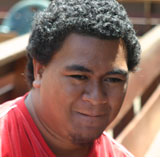 William Augafa, Asili, Oct. 12 The only deaths in Asili were two Koreans, a mother and daughter, who were new to the village and had recently opened a shop. They had not learned about tsunamis, so when they saw the water they ran into their shop and shut the door. They both died in the shop when it was destroyed. |
 Maugotega Savane, Asili, Oct. 12 His home was destroyed and he lost a family member. |
 Fasifua Fuimaono, Fagasa, Oct. 13 Fasifua is 73 years old and this is the first tsunami he experienced in his “entire life.” He is a retired teacher and police officer. His home was inundated but no one in his family killed. He gave valuable information on the origin of large boulders moved by the tsunami, two of which had moved not inland but near parallel to the shoreline. |
 Fili Tua, Fagasa, Oct. 13 Experienced the tsunami at Fagasa. Recalled witnessing tsunami of 1960. |
 Tufiaga Fatuese, Lalomanu, Oct. 15 The wave was “very black and animal-like.” She survived by grabbing and floating with a breadfruit tree. |
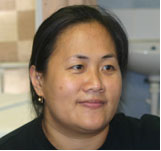 Dr. Juinileti Change Wai, Oct. 15 Wounds sutured immediately following the event, had to be reopened due to infection from bacteria not disinfected during initial treatment. Dysentery struck beginning about two weeks after event. Need for PTSD treatment for survivors and 1st responders. |
(photo withheld) Local nurse. Name withheld by request, Oct. 15 Described lack of training and preparedness of first responders to deal with consequences of a tsunami event. |
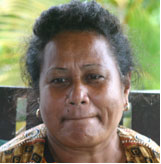 Sose Taupega, Cape Tapaga, Lalomanu, Oct. 15 Following the earthquake she started to pray. She had heard about tsunamis but did not believe it would happen. |
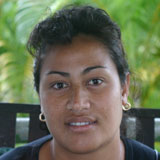 Beauty Tapana Suamolia, Cape Tapaga, Lalomanu, Oct. 15 Walking down the beach following the quake, her husband joked “Watch out for the wave.” When he actually saw the first wave, he picked up one of their children and started running. Beauty looked toward the sea and saw a “black cloud” but did not believe it was a wave. It “crawled” toward her and looked like a “thief.” |
 Otele Samuelu, Cape Tapaga, Lalomanu, Oct. 15 When he felt the quake he rushed to warn tourist at the Taufua Beach Fales where he worked. He finally began running himself and was almost caught in a wave. |
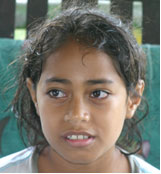 Misiona, Cape Tapaga, Lalomanu, Oct. 15 This ten year old girl was taken by the waves but found something to hold on to and survived. |
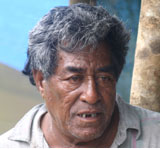 Fata Pule, Saleapaga, Oct. 16 Following the earthquake he turned on the TV to see if there as a warning from Apia. There was none, but he decided that they should head inland. He remembers three waves, with the second and third being the strongest. By the time they were caught by the waves, they were far enough inland to not be swept up. |
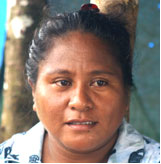 Tina Pule, Saleapaga, Oct. 16 Because the earthquake was “stronger than usual” she told her parents to go inland. She packed clothes and then evacuated. Now she is afraid to “look at the waves.” She was thankful for programs that explained tsunamis because she knew what to do. She will not send her children back to school until a new school is built inland. |
 Fetaomi Livi, Saleapaga, Oct. 16 The wave looked like a “cloud.” She said there were three waves but the second was the worst. She will not send her children back to school until a new school is built inland. |
 Momoe Smith, Saleapaga, Oct. 16 Momoe (sister of Fetaomi Livi) flew up from Auckland, New Zealand as soon as she heard her village was struck. She was surprised at the damage. She was helping the family establish themselves in a house upslope inland. |
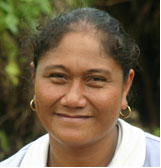 Ato Falefata, Saleapaga, Oct. 16 She saw the wave “higher than coconut trees” and described noises that sounded like “war and machine guns.” |
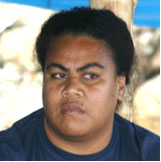 Tamalii Eti, Vaigalu, Lepa, Oct. 16 When she saw the water receding, she started running. Her father and was caught by a wave and injured. They are now living in a house salvaged from the debris but wants to move inland. They are afraid. |
Her husband saw the sea receding and began running inland with their two children. She stayed and watched the sea for a while but then began running. She fell and was under the wave but was saved by her younger brother who pulled her up and grabbed a tree that saved them. She is 8 months pregnant and the fetus is fine. |
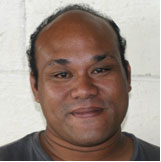 Michael Fatialofa, Vaigalu, Lepa, Oct. 16 He saw the sea retreating and knew that something would happen because he had heard warnings before. He ran up the rocky hill behind the house. The river diverted much of the water inland. The second wave was the strongest. They want to move inland and leave the beach house for guests. |
 Seuaito Fatialofa, Vaigalu, Lepa, Oct. 16 They felt the earthquake, but they had felt many before with no tsunami. He saw the wave coming from the western side of the village because of the break in the reef there. |
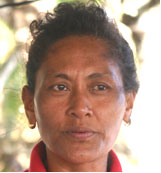 Faatasia Fatialofa, Vaigalu, Lepa, Oct. 16 She looked at the sea and saw only black lava rocks, the water had receded. The river near their house was very strong and almost pulled them in. |
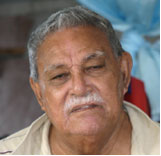 Toomalatai Lauvai II, Vailoa, Aleipata, Oct. 17 He was caught in the wave, washed inland and then back. His leg was injured by a tree so he tried crawling to his brother's house. His wife Sesa was killed. |
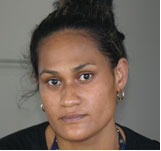 Melisa Faoafa Ian, Vailoa, Aleipata, Oct. 17 She was eight months pregnant and standing at the door holding her child when the wave hit her from behind. They were all washed inland and almost drowned. They were then pulled out to sea and found a piece of timber to hold on to. Her mother-in-law (Sesa) called out that she was tired. The second wave came and washed her, her husband, and child back up the main road. Sesa was found later still in the water. |
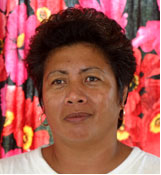 Salaevalu Ulberg, Manager, Namua Beach Fales, Mutiatele, Aleipata, Oct. 17 She listened to the radio for a warning but none came. Then she heard a noise like an airplane about to take off. She looked in the direction of Fanuatapu and saw a “dark thing” coming. What she saw did not look like a wave, but a “beast jumping up from the sea.” Things were “flying out of it.” She stood “looking at the monster as it stood up from the channel” only then was a wave created. The second wave came from both sides of the island and moved inland. Sala believes the event happened because Samoans have forgotten about God and “party on Sunday.” |
 Niuula Toomalatai, Vailoa, Aleipata, Oct. 17 He could hear water in motion that sounded like large motor vehicles in low gear. It “looked white and came from two directions.” The wave had “split around Cape Tapaga.” He described the wave as “hot” and had a “very bad smell.” |
 Faiuga Talavou, Vailoa, Aleipata, Oct. 17 She stood with her back facing the wall and held her young baby tightly to her chest. The other two children stood one on each shoulder. Two waves came and they were under water. They knew that if they died, they “would die together.” She says that now she does not sleep and asks her husband to keep checking the ocean. |
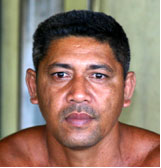 Talavou Toomalatai, Vailoa, Aleipata, Oct. 17 He felt the earthquake but only became concerned when he saw people running inland. He ran toward their house but had to swim as the water came in. He reached his Uncle in about 5 minutes and took him to safety and then headed toward his Auntie and was caught by a wave heading back out. He managed to catch a big tree and held on. Then he dived under the water and it was very dark. He found his Auntie (Sesa) bloated with sea water. |